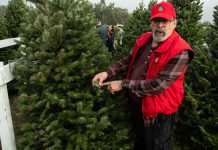Nursery owner Zenichiro Uchida honored for immigration
program
By Martin Cheek, Special to the Dispatch
Monterey – Fifty years ago, Gilroy’s Zenichiro Uchida planted a seed that helped make the world a better place. His efforts were honored Saturday by many of the people whose lives he transformed through a major Japanese immigration program to the United States.
Uchida’s efforts helped more than 1,000 men, women and children from the Kagoshima region of Japan rebuild their lives in California. At a weekend banquet honoring him at the Monterey Hyatt hotel, about 250 of those people and their children expressed their gratitude.
In a speech translated by his son Ted Uchida, the octogenarian particularly emphasized to the children and grandchildren of the immigrants that they must continue his dream of developing relations between Japan and the U.S.
“Now we are in the mainstream of America,” he said. “It’s time for us to give back to America and Japan, to be the peace builders, the army of peace that your parents were when they came here.”
During World War II, Uchida served as a second lieutenant in the Japanese Imperial Army and survived major battles in the Pacific regions of New Guinea and the Philippines.
Uchida was impressed by the kindness American soldiers showed the Japanese people when the nation surrendered. Because of their compassion, he began to see his former enemies in a different light.
To develop modern farming techniques in Japan, in 1953 the Japanese government sent Uchida and other farmers to the U.S. on a 10-month agricultural exchange program. He met Japanese-Americans farmers in the Bay Area, San Diego and Fresno and learned of the many opportunities America gave immigrants. The trip inspired in him a dream to build a bridge between Japan and the land of his former enemy.
Uchida returned to his hometown of Kushikino and proposed to fellow villagers they build new lives in America. Son Ted, who was 2 years old at that time, recalled his father’s ambitious idea. “He said, ‘We have a chance to go to America. Are there any takers?'”
Among those who listened was an 18-year-old named Yoshimitsu “Yosh” Toya.
“I had just finished high school,” Toya remembered. “I had been helping with (Uchida’s) farming. My dream was to be a farmer in California.”
Uchida worked with the American government. He met with officials in the Japanese American Citizens League and found sponsors in the Bay Area, Fresno and San Diego who promised to help the immigrants establish themselves in the U.S.
During this period, he also received death threats from Communists living in Japan. As part of its intimidation, the Communists burned down the Uchida family’s barn one night. Still, the threats didn’t dissuade Uchida.
In 1955, the U.S. government granted the first allotment of visas and 325 Kagoshima men moved to California. They lived in labor camps for three years before being allowed to start farms. After they obtained their citizenship over a five-year period, they then brought their wives and children across the Pacific.
During the long wait, the men often felt homesick for their loved ones. Uchida took home movies with an 8-millimeter camera which allowed the men to see their families. He also shot film of the men’s lives in California to show back in Kagoshima. Some of the footage was shown at Saturday’s banquet.
Toya recalled his amazement at first seeing California’s Central Valley as a teen boy fresh from Japan.
“Beautiful,” he said. “Everything was beautiful. I thought, ‘This is my country. My future. This is the country where they’ll bury my bones.'”
As a farm laborer, Toya worked planting and picking crops in the Fresno region. One day he told Uchida that the farming life was not for him.
Zenichiro encouraged him to follow his heart. Toya went to San Francisco and started attending beauty school. Upon graduation, he found an apprenticeship with stylist Vidal Sassoon. He also married a Japanese American woman.
Eventually, he built his own hairstyling empire. His Yosh for Hair salons in San Francisco and Palo Alto became famous among style-conscious Bay Area women.
“I was lucky to part of this group,” Toya said of his experience 50 years ago in coming to California. “To me, Mr. Uchida is a leader. He’s a guide to me. He brought me to the United States and gave great direction to me.”
In the 1960s, Uchida established his own roots. He brought his wife Shizuko, son Ted and daughter Tomiko to California and built the family’s flower nursery business in the Salinas Valley. About 28 years ago, he moved the nursery to the South Valley. Commuters on U.S. 101 pass the Zen Flower Gardens shop just south of Gilroy every day.
In the 1970s, Uchida began a sister city program between Salinas and Kushikino. In the 1980s, he initiated a sister city relationship between Gilroy and the town of Takko-Machi.
To help celebrate the 50 year anniversary of the immigration, Japan’s Prime Minister Junichiro Koizumi sent an official document congratulating the immigrants.
Fifty years ago, Shinei Honda served as an official in the Japanese Young Farmers Training Program which gave Uchida his initial trip to California.
“He spent all his energy to help the poor families,” Honda said. “He spent all his time and money to develop this immigrant program.”
Honda believes it’s appropriate that Uchida came from the Kagoshima region of Japan because it’s also known for being the home where Takamori Saigo, “the Last Samurai” lives.
“Mr. Uchida is the one who lives the ‘satsuma,’ the spirit of the samurai,” he said. “It’s the spirit of what you can do for you country.”
Letter of Recognition
To the North American Kagoshima Immigrants Association,
I would like to congratulate the people who immigrated to California on your 50th anniversary celebration. My father is from Kagoshima, so I feel very near and dear to you all. For all the hardship you have endured, I would like to extend my heartfelt gratitude and acknowledge your efforts.
California and Kagoshima have one thing in common. The person who was the wine producer and a pioneer for the California wine industry was from Kagoshima in the early 20th century. His name is Kanae Nagasawa.
I look forward for you to have a deeper relationship with Kagoshima and California as well as your sister city program. I am praying for the North American Kagoshima Immigrants Association’s strength and prosperity.
From Prime Minister of Japan, Junichiro Koizumi












